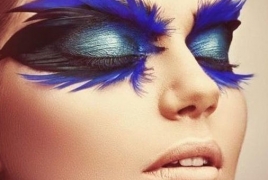 ‘Woman without paint is like food without salt’History of makeup The history of cosmetics spans at least 6000 years and is present in almost every society on earth. Some argue that cosmetic body art was the earliest form of ritual in human culture, dating over 100,000 years ago from the African Middle Stone Age. The evidence for this comes in the form of utilized red mineral pigments (red ochre) including crayons associated with the emergence of Homo sapiens in Africa. PanARMENIAN.Net - The earliest historical record of makeup comes from the 1st Dynasty of Egypt (c.3100-2907 BC). Tombs from this era have revealed unguent jars, which in later periods were scented. Unguent was a substance extensively used by men and women to keep their skin hydrated and supple and to avoid wrinkles from the dry heat. The women of Egypt also decorated their eyes by applying dark green color to the under lid and blackening the lashes and the upper lid with kohl, which was made from antimony (a metallic element) or soot. Women wore white lead and chalk on their faces in Greco-Roman society. However, keeping skin clear and soft was also a high priority in the Greek culture. Honey and olive oil were both used for cleaning and moisturizing the skin. In ancient Greece, makeup was worn by high society daily. Many women would use eyeliner made with olive oil and charcoal to darken their eyes. This eyeliner was also used to create a thick brow, which was very popular at that time. Red iron oxide was mixed with beeswax to create a shiny and long lasting lip balm. Roman philosopher Plautus (254-184 BC) wrote, "A woman without paint is like food without salt." Persian women used henna dyes to stain their hair and faces with the belief that these dyes enabled them to summon the majesty of the earth. During the European Middle Ages, pale skin was a sign of wealth. Sixth century women sought drastic measures to achieve that look by bleeding themselves, although, in contrast, Spanish prostitutes wore pink makeup. Thirteenth century affluent women donned pink lipstick as proof they could afford synthetic makeup. During the Italian Renaissance, lead pain was used to lighten the face, which was very damaging to the wearer. Aqua Toffana was a popular face powder named for its creator, Signora Toffana. Made from arsenic, Signora Toffana instructed her rich clientele to apply the makeup only when their husbands were around. According to the historians and archeologist, 5000 years ago nail polish was created in China where it was used by ruling class to distinguish themselves from the general population. Popular colors were of metallic nature and they symbolized power and wealth, such as silver and gold. One difference between China and other ancient civilizations that used nail polish was that this cosmetic product was not allowed to be used by general population. Several reports survived of public execution of common people who were caught with colored nails still survived today. From China, nail polish spread across India, Middle East and northern Africa, where it was extensively used in Egypt. As with many other cosmetic products, nail polish disappeared from the European fashion after the fall of Roman Empire. It was only after the arrival of renaissance and the new trade connection with the Middle East and India that European aristocracy gain access to the nail polish. As the centuries went, nail polish and manicures became more and more commonplace, finally becoming commonplace in France during late 18th century. By the turn of 19th century nail polish and coloring became more common among general population in France, England, Italy and United States, but it was in the early 20th century when nail polish became truly popular, with manicure establishments appearing in France at great numbers (especially in 1920s and 30s). In the long prehistoric periods lipsticks were made only from readily available natural sources – fruit and plant juices. As early civilizations started appearing in the Middle East, North Africa and India, advanced manufacturing processes enabled mankind to finally start producing new kinds of lipsticks. First ones to do so were Mesopotamian women, who grinded out precious gems and used their dust to decorate their lips with glimmer and riches. Women from Indus Valley Civilization used lipstick regularly, but it was Egypt where manufacture of lipstick received many advancements. There, royal members, clergy and high class used several types of lipsticks, some of them with recipes that contained poisonous ingredients that could cause serious illnesses. By the end of the 19th century, Guerlain, a French cosmetic company, began to manufacture lipstick. The first commercial lipstick had been invented in 1884, by perfumers in Paris, France. It was covered in silk paper and made from deer tallow, castor oil, and beeswax. Today's multibillion dollar cosmetic industry must meet strict government regulations about what it can and cannot include in products and must follow safe manufacturing guidelines. Nowadays, the most serious injury you're likely to receive from your cosmetics is an irritation or a rash from using a product that's too harsh for your skin. Yet, despite decades of safety testing and a safety record unparalleled in many industries, there are many myths circulating about the dangers of cosmetic ingredients. Lusine Mkrtumova / PanARMENIAN.Net Marriages by mail Green tourism on the rise in Syunik This winter is ideal for it The cableway, the shoe and the unicycle The growing trend of human microchipping Holy Etchmiadzin prefers solar energy Friendship heals |